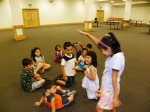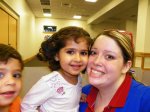I’m writing this in my PJs, while my roommate Whitney decorates our house with artwork some of our kids drew us. We just got home from our second night of childcare during the RIS ESL summer program, and we should be doing dishes from dinner but we’re just too excited. (So excited, I can’t do anything but blog about it!)
Tuesday night, the childcare was crazy. It was the first night, and we probably had 23 kids… most of whom were under the age of 5. (Most of them had not been pre-registered by their parents, and we were expecting to have mostly older kids.) There were 3 of us helping (Whitney, a Bonner student from U of R named Thomas, and myself) but it was impossible for us to keep track of everyone, or stop them from opening the doors and going to find their parents in the classrooms, or take them to go to the bathroom, or stop them from eating crayons, or… well, my supervisor congratulated us afterward for surviving.
So going into tonight’s session, we had a plan: Thomas would take the older ones into the gym; Whitney and I would keep the 5-and-under crowd doing crafts. There were more kids than last time. Whitney and I had 22, and Thomas had 9. In our room, everyone sat at the table and we went around and said our names and something we liked to do. (“I’m Katherine, and I like to bake cookies!” “I’m Whitney, and I like to play with dinosaurs!”) We then said our favorite animals and tried to draw them. I drew a really beautiful magenta dog saying woof, and I helped one girl next to me draw a giraffe. The girl on the other side of me drew some colorful scribbles, but it was a pretty drawing and I saved it after she left. At the other end of the table, Whitney miraculously kept the crying babies (including a set of twins) under control. The drawing party lasted for a good hour until everyone started to get antsy… and get up and run around…
We’d talked about switching the groups and having the older ones come in to color while the little ones ran around in the gym with Thomas, but then we decided not to disrupt Thomas’s group, since it was still going really well. He did a great job of tiring them out by the end! So we improvised. I grabbed a couple of plastic balls from the gym and had everyone sit in a circle on the floor. We played a “name game” where, when you hold the ball, you say something about yourself; everyone else raises their hand if it’s true about them, and you toss the ball to someone whose hand is raised (courtesy of summer camp). Whitney was still quieting down babies and being amazing, so I supervised the game. Now, a lot of these kids have very limited English, and I’m pretty sure some of the boys didn’t understand what was being said. One of them raised his hand when a girl said she liked wearing dresses… And other kids were just sitting there, not really participating or responding. Some of them had come to America really recently. As we’d learned on Tuesday, some of them had never been away from their parents before. There’s one sassy little girl who will tell me a small monologue in Egyptian, and it’s really difficult to know how to respond. So the name game was moderately successful (everyone had to be sitting in order to play) but after a while the excitement fizzled out.
The last thing I tried with them was a game of Duck Duck Goose, and it was a major victory. All the ones who were past high-chair age formed a circle; the littlest ones stayed in their high chairs with Whitney. (She even had to change a diaper, but she got to teach them what “pink” meant.) As I started to explain the rules, one boy said, “That’s boring!” I said, “Oh, so you’ve played it before?” He said, “No, I’ve never played it,” and then he ended up being one of the most enthusiastic ones! Another boy, who would only say “Yes” no matter what you asked him and hadn’t been fully involved in the earlier activities, was the first one to tag “it” before “it” made her way back around the circle. He was so proud of this accomplishment that, after that, he’d run up and tag “it” even when it wasn’t his turn. The three most talkative girls (cuties! I’m obsessed) would explain to the younger ones how to play, and sometimes hold the hand of a littler one and help her pick a goose. It was the perfect activity to keep them entertained and get some of them out of their shells. Plus, I got to run around–they kept wanting me to be the goose! The whole thing was beautiful. I can’t wait for next Tuesday.
















